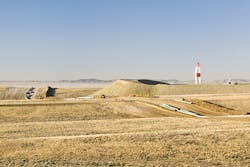Proposed gas pipeline safety rule has big problems, trade groups say
Groups representing the natural gas industry filed comments Aug. 16 that warned of fundamental flaws of legal authority and practical details in a proposed rule on gas pipeline leak detection and repair published by the Pipeline and Hazardous Materials Safety Administration (PHMSA).
Basic elements of the proposal would exceed the mandate Congress has given PHMSA, would be infeasible, needlessly burdensome, and based on inadequate cost-benefit analyses, according to the groups.
The proposed rule, published May 18 in the Federal Register, is intended to implement Sections 113 and 114 of the Protecting our Infrastructure of Pipelines and Enhancing Safety Act of 2020, or the PIPES Act of 2020. Those sections focus not only on leak detection and repair but inspection and maintenance programs. They apply to onshore gas gathering, transmission, and distribution lines, offshore gathering lines, and to 165 liquefied natural gas plants and 403 underground gas storage sites.
Industry groups jointly filed recommendations Aug. 16 in hopes of improving the proposal. The joint filing came from the American Gas Association, Interstate Natural Gas Association of America (INGAA), American Public Gas Association, American Petroleum Institute, GPA Midstream Association, American Fuel & Petrochemical Manufacturers, and Northeast Gas Association.
Leaks and hazardous leaks
The concerns raised by the associations start from elements as basic as how to deal with hazardous as opposed to non-hazardous leaks. The proposed rule would treat “leaks” and “hazardous leaks” as synonymous, the groups said, though Congress did not do so in the PIPES Act.
The associations said criteria for hazardous leaks “should remain primarily focused on existing or probable hazard to persons or property, as this determination is one that can be most realistically made using the judgment of operating personnel at the scene of a leak.”
PHMSA’s proposed definitions would result in an expansive regulatory regime that, contrary to Congress’ intent, would require operators to identify and repair all detectable leaks, including those so inconsequential that they pose no potential hazard to public safety and no or de minimis impact on the environment, the groups said.
The associations also said the 6-month time frame for a final rule to become effective is not realistic or achievable. They urged a 3-year effective date be adopted.
They also said proposed standards for alternative leak detection technology were unreasonable and, in some cases, infeasible.
Costs and benefits
PHMSA’s analysis understates the costs and overstates the benefits of the proposed compliance activities, the associations said. INGAA evaluated the costs of the proposed rule and estimated that the costs for gas transmission operators will be $228-516 million annually, in comparison to PHMSA’s assumption of $14.9 million per year.
The proposed rule makes much of the Biden administration’s determination to reduce methane and other greenhouse gas (GHG) emissions to limit global warming. The associations noted a big difference between what PHMSA estimates as the benefits of methane controls versus what the Environmental Protection Agency (EPA) recently estimated.
“PHMSA’s cost effectiveness figure is $23,763 per metric ton of methane,” the associations said. “By comparison, in 2022, EPA, the lead federal environmental regulator, used a cost effectiveness calculation of $1,970/ton.”
The regulatory agency “is poised to enact burdensome measures on natural gas pipeline operators and natural gas utilities” and cannot escape its obligation to conduct an adequate cost and benefit assessment in accordance with the Pipeline Safety Act and guidance from the Office of Management and Budget, the groups said.
It appears that PHMSA “assumed significant environmental benefits related to repairing small, Grade 3 leaks while failing to fully account for the cost and, significantly, the GHG emissions resulting from operators having to conduct additional surveys to locate, excavate and repair these small, non-hazardous leaks and then conduct a post-repair check,” the groups said.
“In fact, in many cases, industry’s analysis indicates that the GHG emissions resulting from the identification and repair of these small leaks, and the post-repair recheck, will produce more GHG emissions than repairing the leak, eliminating any climate benefits resulting from completing the repair,” the groups said.
About the Author
Alan Kovski
Washington Correspondent
Alan Kovski worked as OGJ's Washington Correspondent from 2019 through 2023.
